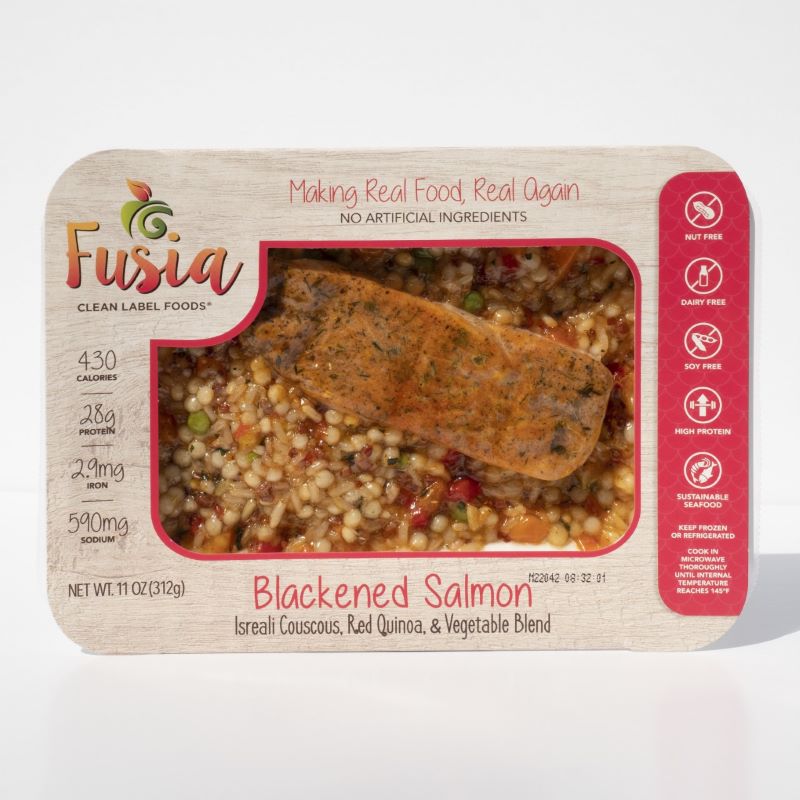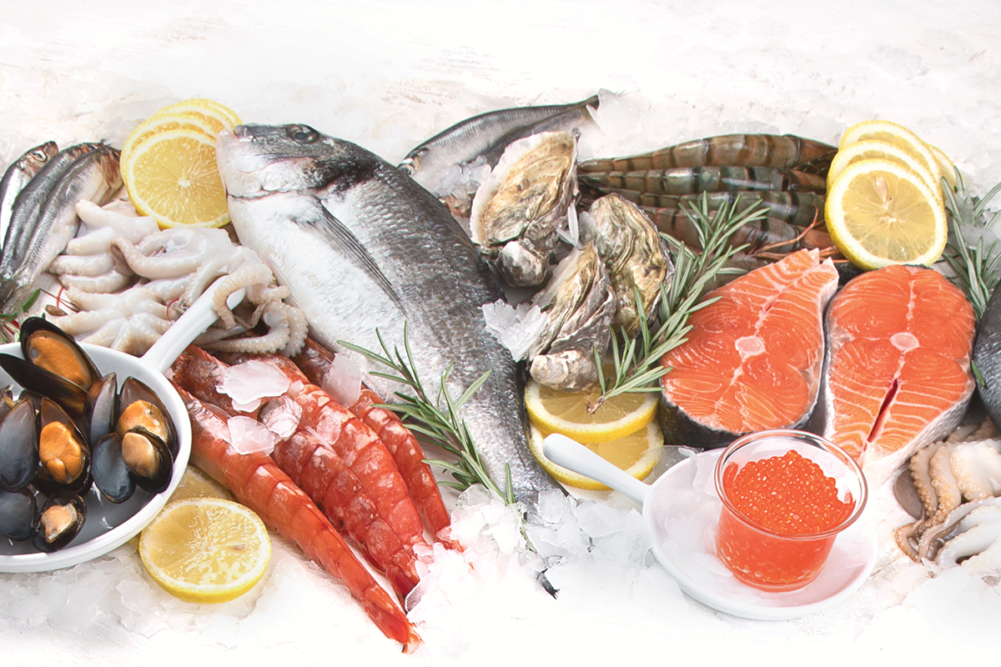Despite a drop in sales of prepared seafood items in recent months, shoppers are seeking out innovative grab-and-go solutions.
While sales of value-added seafood items surged 12.2% in 2021 to $1.4 billion, according to IRI, anecdotal reports show a slowing of the convenient meal solutions in supermarkets as consumers worry about inflation and return to restaurants.
Sales of seafood cakes dropped around 9% in March versus March 2021, IRI and 210 Analytics found. On the other hand, prepared seafood salad sales soared 22% this March.
Encino, Calif.-based Gelson’s Market has continued to see a decline in the category this year with restaurants opening back up and consumers returning to eating out more, said Sean Saenz, senior director of meat and seafood at Gelson’s.
“Sales are still positive compared to 2019, but nowhere near the 25% [lift in sales] in 2020 and 2021,” Saenz said. The surge in sales over the last two years can primarily be attributed to “consumers looking for convenience and willing to try more options, while cooking more at home,” he added
“The economy may have a different impact on seafood and prepared foods within this category,” said Guy Pizzuti, business development director of seafood for Lakeland, Fla.-based Publix. “Prepared items tend to come at a higher retail price point. Customers may opt to purchase the base seafood and prepare the recipe at home.”
Fresh seafood sales have lost some of their pandemic momentum in the last six months, said Anne-Marie Roerink, principal at San Antonio-based 210 Analytics.
“In all fairness, when compared to pre-pandemic, seafood sales are still highly elevated. If fewer people are buying fresh seafood or buying it less often, it’s hard for value-added to still see growth,” Roerink said. "Yet, we absolutely see that above-average performance continue for all things value-added, whether seafood, meat or produce.”
While shoppers are very concerned about inflation and value-added items are priced at a premium, there are “several powerful underlying currents" driving the continued popularity of value added items, including seafood meal kits, shrimp kabobs, marinated items and more, Roerink said.
“Convenience and saving time immediately comes to mind, and that is the biggest reason, for sure. Our lives are as busy as they used to be, yet we’re dealing with 40-year high inflation and have gotten used to cooking at home a bit more,” Roerink said. “So the scramble to figure out the time versus money puzzle is back on and that’s where value added wins. People feel it’s still a lot cheaper than eating out at a restaurant. But it’s not just about saving time, it’s also about eating something different and knowing that an expert has done the flavor development and it’s going to be great.”
Some shoppers also say they like buying value-added because that means they don’t have to buy all the individual ingredients, according to Roerink.
“How often do you see a fun recipe, but when looking at the ingredients you’re always missing one or two crucial ingredients that you doubt you’ll ever use again? Those are all very strong reasons to create willingness to pay a little more, knowing you’re at least one step closer to a great meal,” Roerink said.
Seafood salads realize double-digit growth
While sales of some value-added seafood items have declined, seafood salads’ sales growth of 22% is benefitting overall fresh seafood sales.
“This continued growth is mostly due to convenience, fresh offerings and continued options made available to the consumer,” Saenz noted.
For example, Gelson’s offers self-serve poke stations where shoppers can create poke rice bowls or salads or they can choose pre-packaged popular items like spicy Hawaiian Ahi Tuna Poke Salad and Sriracha Cooked Shrimp Poke Salad.

Gelson’s is running a test of an exclusive plant-based ahi tuna poke salad recipe developed in-house in eight of its stores.
“So far, it’s performing very well and is adding to the year-over-year double digit sales growth we are seeing on the fresh seafood salad bar category,” Saenz said.
While Saenz doesn’t expect the plant-based option to achieve the same volume as its seafood-based pokes, it’s “nice to continue to differentiate ourselves from our competitors.”
Publix is also seeing an uptick in prepared salads, “driven by the convenience factor within the snacking category,” Pizzuti said. Publix offers a traditional seafood salad, a tuna salad, and a seafood pasta salad.
However, similar to the overall prepared seafood category, salads may be impacted in their performance due to the economy, PIzzuti added.
Seafood salads have done “tremendously well over the past year and continue to be one of the few areas that is growing sales in the first quarter of 2022,” Roerink said.
“I think it has everything to do with usage occasions. We’ve seen the full on return of entertaining. After being apart for many months, people are getting back together just to hang out, birthday parties are back on and all the big holidays are seeing engagement that is nearly back to pre-pandemic levels. That means we’re seeing items like shrimp platters and seafood salad make a return, just like we see huge gains in fruit trays and deli prepared sandwich trays and the like,” she added.
Retailers can have some fun with limited time offers, especially if they develop seafood salads in-store, Roerink suggested.
“It provides an opportunity to change up species and flavors and introduce people to new items.”
Popular and innovative value-added seafood
Adding innovative flavors and variations of value-added seafood — including steam-in-bag and microwavable meals — continue to spur growth in the category.
Among Publix’s more popular prepared seafood items is its marinated salmon lines and appetizers. Offering marinated salmon portions on their own is beneficial, according to Pizzuti, because there is a growing segment of customers that do not want the starch and vegetable to be decided for them.

Gelson’s does well with offering live lobsters and fresh peeled and deveined wild-caught Mexican shrimp, steam-cooked in-house, Saenz noted.
Among the innovative new products is vacuum-packed, ready-to-microwave shrimp and salmon meals in the fresh or frozen seafood sections at grocery chains such as Publix.
The supplier, Elk Ridge, Md.-based Clean Label Gourmet Foods, vacuum-seals the tray and then pressurizes it at extremely high pressure, which protects against inactive bacteria and viruses. As a result, the shelf life on the meals is two years frozen and 45 days refrigerated, according to Todd English, vice president of sustainability for Boise, Idaho, U.S.A.-based Riverence Group, which supplies the sustainable seafood for the meals.
The seafood meals — which include Thai Style Salmon, Blackened Salmon, and Shrimp Stir Fry — contain only a few ingredients, and zero additives and preservatives, according to English.

Pittsburgh-based Giant Eagle has had success with value-added items from Seattle-based Orca Bay Foods, such as garlic parmesan salmon portions and honey jalapeno salmon. Blackened and bourbon salmon portions from Miami-based Camanchaca, added in spring 2020, “have also done extremely well for us,” said Shawn Oliver, seafood category manager for Giant Eagle.
Several retailers have also realized success with sauced, fully-cooked shrimp, said Cody Masters, R&D and executive chef at Signal Hill, Calif.-based Everson Spice Co / Lynn’s Foods.
“The beauty of this program is the various ways in which it can be merchandised. For example, as a lunch bowl, you are working with smaller portions, sold at a premium. Or, bigger picture, any given weekend there is a sporting event, holiday, etc., that these can be marketed as an efficient and cost-effective app or hors d’oeuvres for,” Masters said. “Literally, the odds are that every day, a customer will see this option and find purpose in something that requires minimal labor or effort to produce at store level.”

